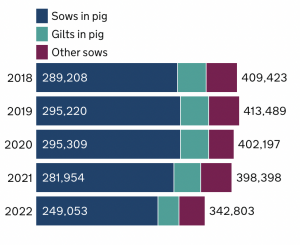The UK female breeding herd decreased by 14% to a 20-year low in the year to June 2022, according to new figures published by Defra.
The figures are based on the June agricultural census, although there is some uncertainty over the data as estimated figures have been used for both Scotland and Northern Ireland.
The figures show, overall, a 2.5% reduction to 5.2 million pigs in the UK. The reduction is driven largely driven by a 15% fall in the number of breeding pigs.
The female breeding herd accounts for the vast majority of breeding pigs and numbers dropped by 14%, falling to 343,000 in the year to June, the lowest it has been in the past 20 years.
Large decreases were seen across all categories. In-pig sow numbers were down from 282,000 to 249,000, an 11.5% drop, while there were 12,000 fewer gilts in pig, at 41,600, a proportionally bigger 22% reduction, while ‘other sow’, including dry sows were down by 17% to 52,000.
The number of fattening pigs in the UK decreased by 1.1% to just under 4.8 million, according to the survey.
In September, Defra published its June census results for England, showing an 18% reduction in the breeding herd to 261,000, indicating the loss of more than 50,000 sows and gilts as producers went out of production and cut back on sow numbers. It is unclear whether these figures have been updated for the UK survey.
The UK picture is clouded, however, by uncertainty over the figures from Scotland and Northern Ireland. In Scotland, the June Agricultural Census did not take place, with estimates based on Single Application Form (SAF) data provided to Defra instead.
For Northern Ireland, census results due to be published in December 2022 have been delayed to allow extra time to quality assure the data. Results are now expected in January 2023, with results from the 2021 census carried forward to 2022.





